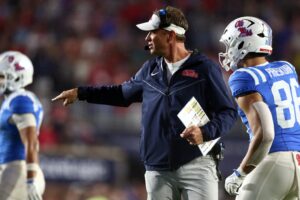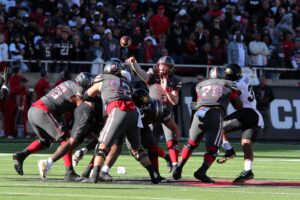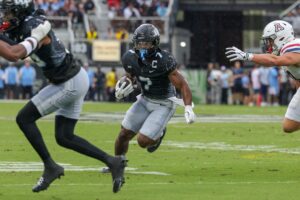Auburn Has More Potential Than Expected
In a game there they weren’t given a chance by the media, the Auburn Tigers were only a few key plays away from pulling off another shocker in an already unbelievable day of college football. They did fall short, however, dropping their season opener to the second ranked Clemson Tigers by a score of 19-13.
For Auburn, it was a game that exposed some aspects of this team that need an immense amount of growth, but at the same time showed a team that has made great strides from last season. While moral victories and silver linings are usually worthless in a business based on winning and losing, this Auburn team showed that it may not be the 5-7 team that everyone expected.
Auburn is playing defense again
For the better part of a decade, Auburn has been a team that featured a high-powered offense, accompanied by a weak defense, a strong shift from traditional Auburn football. While they would produce great players like Nick Fairley and Dee Ford, the Tiger defenses took the phrase “bend, but don’t break” to a whole new level.
This is why Saturday night was such a shock to so many. Led by a strong front, featuring elite defenders in Carl Lawson and Montravius Adams, Auburn held one of the nation’s most potent offenses to only 19 points.
Deshaun Watson, considered by many to be a lock to get to New York for the Heisman Trophy ceremony, went 19 for 34 (55%) for 248 yards, and threw both a touchdown and a an interception.
On third downs, Auburn stopped Clemson on 11 of their 17 tries. They had similar success on fourth down, denying two of Clemson’s three attempts, including a key stop that gave Auburn one last chance to win the game.
Auburn’s defense held one of the nation’s best offenses and a great QB to 399 yards, 19 points and forced 2 turnovers
— Bryan Matthews (@BMattAU) September 4, 2016
If there is a negative to be found in this defensive unit, it is the lack of depth at cornerback. Aside from senior Josh Holsey and sophomore Carlton Davis, Auburn has no experience at the position. Davis was held out of the spring game back in April and suffered a minor injury last night, so defensive coordinator Kevin Steele has to hope that this trend does not continue.
A few bright spots on offense
After losing the top three tailbacks on the depth chart during the off-season, the starting job landed in the lap of sophomore Kerryon Johnson. On Saturday night, he carried the ball 23 times, nearly half his 52-carry total in the entire 2015 season. There was not much else on the ground for Auburn, but Johnson accounted for 94 yards, as well as a late score that brought Auburn back within striking distance.
A similar lack of experience plagues the receiving core. With two of the three leading pass-catchers of 2015 gone, it is up to senior Marcus Davis to carry more of the load. Against Clemson, he was the team’s leading receiver, catching five balls for 56 yards. With the struggles at quarterback, Davis isn’t a guy that will light it up, but he is a reliable, veteran target.
Another member of the receiving core that emerged on Saturday night was Will Hastings. While three catches for 29 yards isn’t a breakout performance, Hastings looked like a solid slot receiver in an offense that needs an underneath option. As Auburn’s crop of athletic, true freshman receivers continue to grow and develop, Hastings is a fundamentally sound receiver with good hands that the quarterback, whoever that may be, can count on.
Gus doesn’t need to outthink the room
Auburn may be a team that is looking to bounce back from two disappointing seasons in a row, but they are still a team that has the ability to win games. This was the case on Saturday night, as they were six points away from beating the second-ranked team in the nation. That is why, for many Auburn supporters, Gus Malzahn’s questionable decision-making was so frustrating.
His first mistake was the quarterback roulette that was being played throughout the game. The expression, “If you’ve got two quarterbacks, you’ve got none”, was proven even truer with Malzahn’s three-man rotation. No one quarterback was allowed to establish any real rhythm, which was a major contributor to Auburn’s three for 17 success rate on third down.
To make matters worse, at any point when a quarterback would make a good play or start to move the offense, they were rotated out. In the first half, Jeremy Johnson completed two passes downfield, hitting his receiver in the numbers, and was then abruptly removed from the game. Later in the half, John Franklin ran the read option with good success two plays in a row, followed by him being removed from the game. Even later in the second half, as Sean White started to have more success running the offense than the other two, he was removed after completing a bomb downfield to Marcus Davis that put Auburn in opposing territory.
Real question: has there ever been a “platoon” quarterback system that had sustained success? Why do coaches (Gus Malzahn) continue to try?
— Darrell Greene (@dgonfox13) September 4, 2016
It’s understandable that the Gus Malzahn offense features a large amount of deception and misdirection, but that is worthless without first establishing an offensive identity. Until he sets a foundation (The Marshall/Mason rushing attack in 2013, Cam Newton’s versatility in 2010), this offense will continue to flounder.
Optimism on the Plains
While in the moment, there was a massive amount of frustration from the Auburn faithful. And after being so close to pulling off a huge upset, there is an optimism that has now settled in. Auburn was expected to go 5-7 or 6-6 and experience another coaching change in 2016. Now that they have taken Clemson and Deshaun Watson into deep water, this team has more potential than most thought.
In 2013, it was a loss to LSU in which Auburn never stopped fighting, that set off a magical season. Maybe a loss to Clemson in 2016, which likewise Auburn never stopped fighting, that will set off a surprisingly successful season and save Gus Malzahn’s job. Just maybe.
Main Photo:






